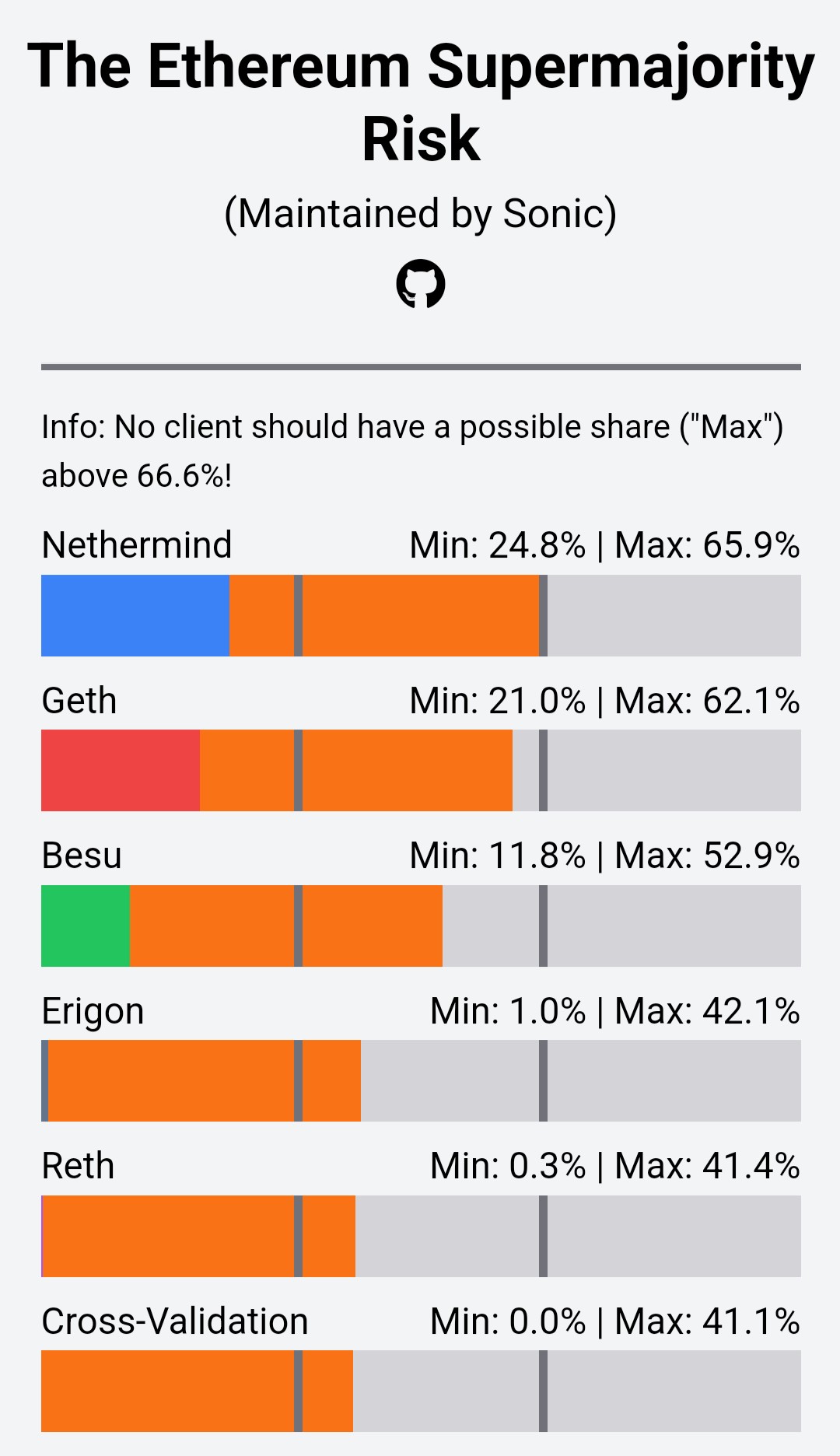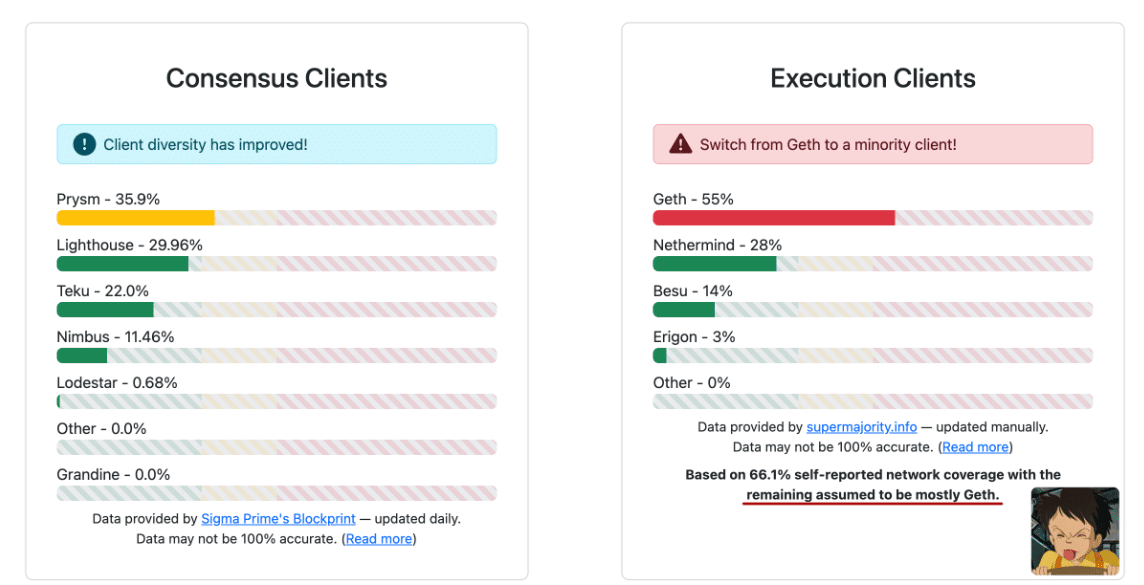- Vitalik Buterin has praised Ethereum for hitting key milestone in the execution layer client diversity.
- Ethereum plans to have multiple execution clients to work in parallel while verifying blocks.
Ethereum [ETH] has achieved a key milestone by limiting top execution clients run by validators from having a supermajority market share. Reacting to the update, Ethereum founder Vitalik Buterin termed it the ‘robustness’ of the ecosystem.
‘No execution client has more than 2/3 market share. Great news for the robustness of the Ethereum L1.’

Source: X/Vitalik Buterin
The problem with ETH supermajority client risk
For context, validators running staking and pools use Ethereum execution client software. A dominant execution client, i.e., the one used by most validators, more than 2/3 of market share, is considered a supermajority client and carries a risk to the entire ecosystem.
According to the Supermajority tracker, a supermajority client could cause a network split and even fund loss in case of bugs.
‘It has the capability to finalize the chain without the agreement of the other clients. A consensus bug within such a client would cause catastrophic results, such as a network split, loss of funds, and reputation damage.’
Additionally, the supermajority client could lead to consensus errors and mistakes from validators (block proposers and verifiers), which could attract severe penalties through slashing (destroying a portion of their stake/deposit).
In short, supermajority client risk translates to centralization risk which could affect the entire ecosystem. According to Ethereum’s Team Lead, Peter Szilágyi, the impact could be dire to even the chain’s adoption.
‘Even worse, if a majority of validators are in the wrong, the bad chain can get finalized, leading to gnarly governance issues of how to recover from the error with perverse incentives from the majority validators not to. Such an event would have the capacity to have a chilling effect on the entire Ethereum adoption.’
In the past, Geth (Go Ethereum) was the most dominant and popular execution layer client until recently.

Source: Ethereum
To mitigate the risk, the ecosystem advocated for client diversity and urged users to opt for minority execution clients. Currently, Nethermind is the most dominant client, surpassing Geth. However, Nethermind was not a supermajority client at the time of writing.
Interestingly, a new proposal has been made to help validator nodes verify blocks with multiple clients in parallel to minimize the supermajority risk further.
In the meantime, the ETH price consolidated below $2800 after Friday’s impressive bounce. It remains to be seen whether investors’ risk-on approach will continue into next week.
- Vitalik Buterin has praised Ethereum for hitting key milestone in the execution layer client diversity.
- Ethereum plans to have multiple execution clients to work in parallel while verifying blocks.
Ethereum [ETH] has achieved a key milestone by limiting top execution clients run by validators from having a supermajority market share. Reacting to the update, Ethereum founder Vitalik Buterin termed it the ‘robustness’ of the ecosystem.
‘No execution client has more than 2/3 market share. Great news for the robustness of the Ethereum L1.’

Source: X/Vitalik Buterin
The problem with ETH supermajority client risk
For context, validators running staking and pools use Ethereum execution client software. A dominant execution client, i.e., the one used by most validators, more than 2/3 of market share, is considered a supermajority client and carries a risk to the entire ecosystem.
According to the Supermajority tracker, a supermajority client could cause a network split and even fund loss in case of bugs.
‘It has the capability to finalize the chain without the agreement of the other clients. A consensus bug within such a client would cause catastrophic results, such as a network split, loss of funds, and reputation damage.’
Additionally, the supermajority client could lead to consensus errors and mistakes from validators (block proposers and verifiers), which could attract severe penalties through slashing (destroying a portion of their stake/deposit).
In short, supermajority client risk translates to centralization risk which could affect the entire ecosystem. According to Ethereum’s Team Lead, Peter Szilágyi, the impact could be dire to even the chain’s adoption.
‘Even worse, if a majority of validators are in the wrong, the bad chain can get finalized, leading to gnarly governance issues of how to recover from the error with perverse incentives from the majority validators not to. Such an event would have the capacity to have a chilling effect on the entire Ethereum adoption.’
In the past, Geth (Go Ethereum) was the most dominant and popular execution layer client until recently.

Source: Ethereum
To mitigate the risk, the ecosystem advocated for client diversity and urged users to opt for minority execution clients. Currently, Nethermind is the most dominant client, surpassing Geth. However, Nethermind was not a supermajority client at the time of writing.
Interestingly, a new proposal has been made to help validator nodes verify blocks with multiple clients in parallel to minimize the supermajority risk further.
In the meantime, the ETH price consolidated below $2800 after Friday’s impressive bounce. It remains to be seen whether investors’ risk-on approach will continue into next week.


















































































how to buy generic clomid without dr prescription clomid pct can you buy clomiphene without insurance generic clomiphene price what is clomid medication how to buy clomiphene can you get cheap clomid without rx
Greetings! Utter useful par‘nesis within this article! It’s the petty changes which choice turn the largest changes. Thanks a lot in the direction of sharing!
This is the stripe of topic I take advantage of reading.
cheap rybelsus 14mg – buy semaglutide 14mg generic order periactin sale
buy generic motilium 10mg – buy flexeril cheap purchase flexeril without prescription
buy inderal without a prescription – cost clopidogrel buy methotrexate 5mg sale
buy augmentin sale – at bio info buy acillin online cheap
buy generic nexium online – https://anexamate.com/ esomeprazole over the counter
buy coumadin 2mg without prescription – anticoagulant hyzaar over the counter
order mobic 7.5mg online – https://moboxsin.com/ buy mobic 7.5mg pill
oral prednisone 10mg – inflammatory bowel diseases order deltasone 20mg online
buy ed pills generic – https://fastedtotake.com/ top erection pills
amoxil buy online – comba moxi amoxicillin us
buy fluconazole 200mg online – https://gpdifluca.com/ fluconazole oral
cenforce without prescription – https://cenforcers.com/# order cenforce generic
cialis for sale brand – https://ciltadgn.com/ cialis free samples
order ranitidine 300mg for sale – https://aranitidine.com/ zantac 300mg generic
cialis price cvs – https://strongtadafl.com/# how much does cialis cost per pill
viagra online generic cheap – generic viagra 50 mg cheapest generic viagra and cialis
Thanks on sharing. It’s first quality. buy neurontin 800mg without prescription
This website exceedingly has all of the bumf and facts I needed to this participant and didn’t identify who to ask. https://ursxdol.com/propecia-tablets-online/
I couldn’t hold back commenting. Profoundly written! https://prohnrg.com/product/diltiazem-online/
This is a topic which is in to my heart… Many thanks! Quite where can I find the connection details an eye to questions? https://ondactone.com/product/domperidone/
Palatable blog you procure here.. It’s hard to espy strong worth writing like yours these days. I honestly recognize individuals like you! Withstand care!! http://www.predictive-datascience.com/forum/member.php?action=profile&uid=44951
buy generic dapagliflozin – janozin.com generic dapagliflozin
orlistat order online – buy generic orlistat orlistat 60mg cost